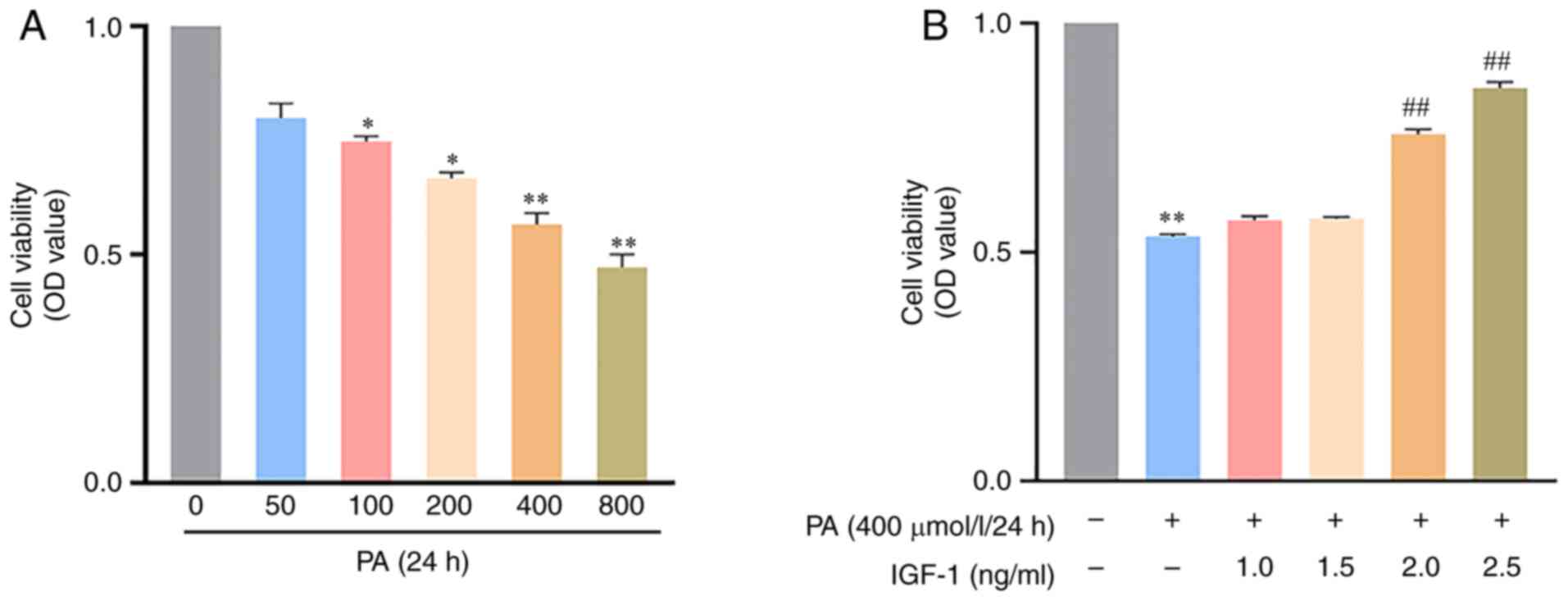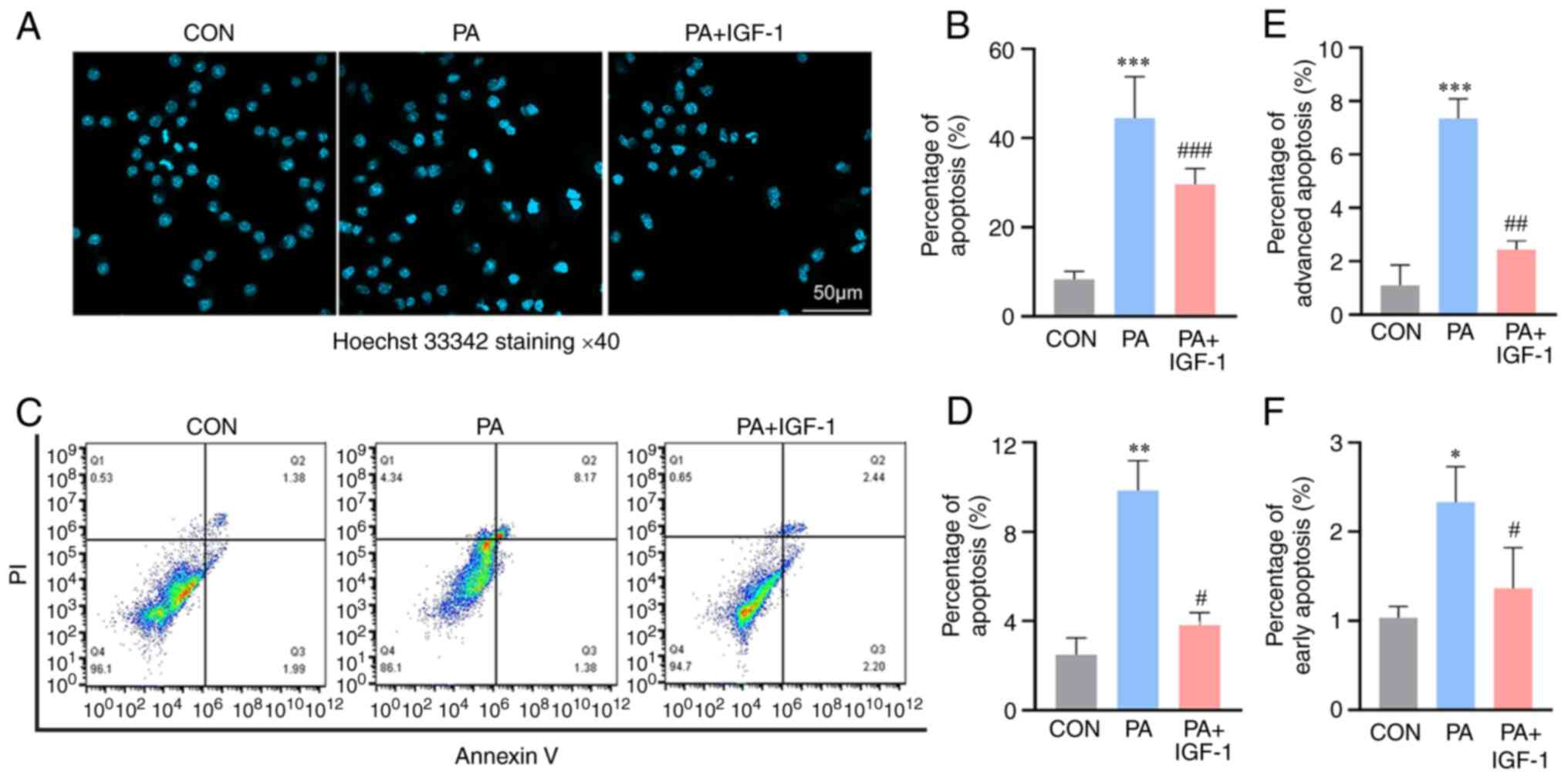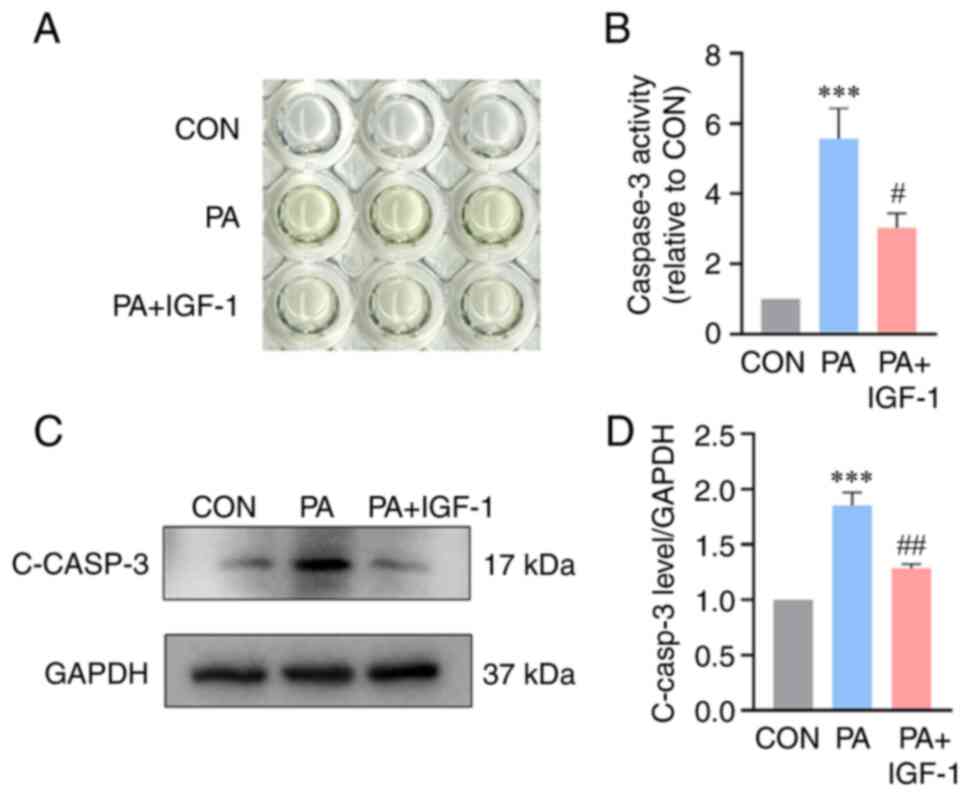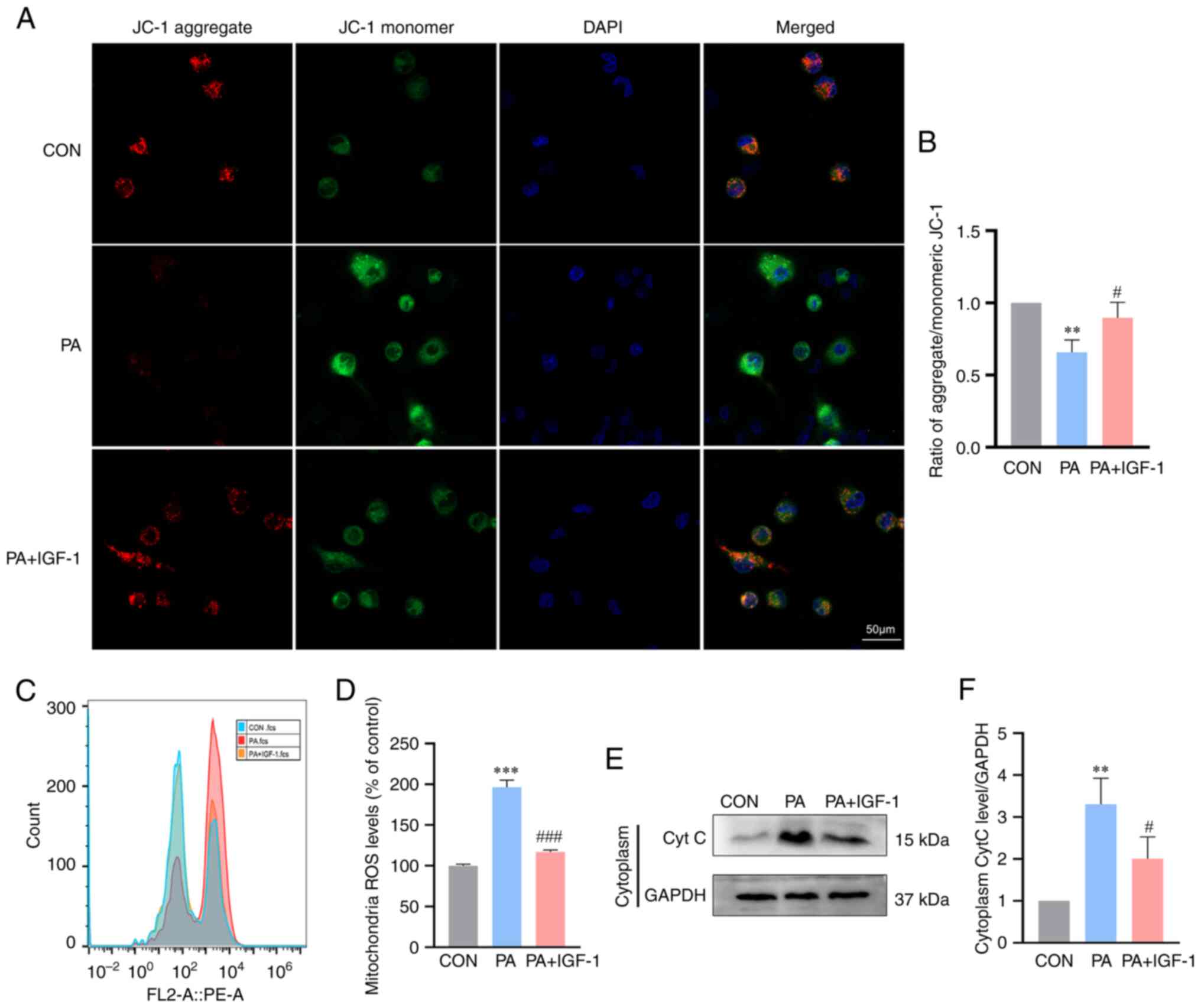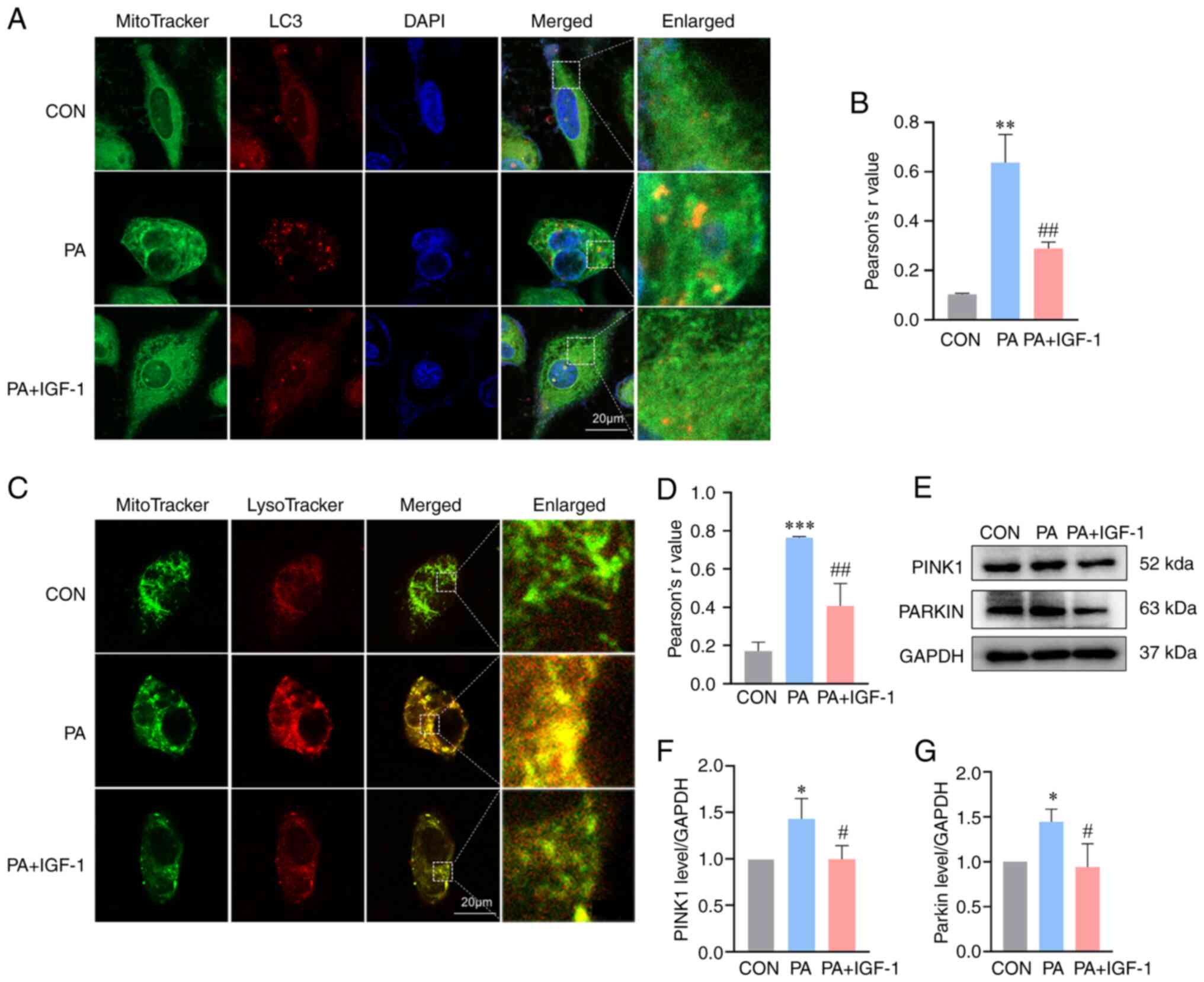|
1
|
Ma XM, Geng K, Law BY, Wang P, Pu YL, Chen
Q, Xu HW, Tan XZ, Jiang ZZ and Xu Y: Lipotoxicity-induced mtDNA
release promotes diabetic cardiomyopathy by activating the
cGAS-STING pathway in obesity-related diabetes. Cell Biol Toxicol.
39:277–299. 2023. View Article : Google Scholar : PubMed/NCBI
|
|
2
|
Unger RH and Scherer PE: Gluttony, sloth
and the metabolic syndrome: A roadmap to lipotoxicity. Trends
Endocrinol Metab. 21:345–352. 2010. View Article : Google Scholar : PubMed/NCBI
|
|
3
|
van der Rijt S, Leemans JC, Florquin S,
Houtkooper RH and Tammaro A: Immunometabolic rewiring of tubular
epithelial cells in kidney disease. Nat Rev Nephrol. 18:588–603.
2022. View Article : Google Scholar : PubMed/NCBI
|
|
4
|
Plotz T, von Hanstein AS, Krummel B,
Laporte A, Mehmeti I and Lenzen S: Structure-toxicity relationships
of saturated and unsaturated free fatty acids for elucidating the
lipotoxic effects in human EndoC-βH1 beta-cells. Biochim Biophys
Acta Mol Basis Dis. 1865:1655252019. View Article : Google Scholar : PubMed/NCBI
|
|
5
|
Tao L, Yi Y, Chen Y, Zhang H, Orning P,
Lien E, Jie J, Zhang W, Xu Q, Li Y, et al: RIP1 kinase activity
promotes steatohepatitis through mediating cell death and
inflammation in macrophages. Cell Death Differ. 28:1418–1433. 2021.
View Article : Google Scholar : PubMed/NCBI
|
|
6
|
Yen CC, Lii CK, Chen CC, Li CC, Tseng MH,
Lo CW, Liu KL, Yang YC and Chen HW: Andrographolide inhibits
lipotoxicity-induced activation of the NLRP3 inflammasome in bone
marrow-derived macrophages. Am J Chin Med. 51:129–147. 2023.
View Article : Google Scholar : PubMed/NCBI
|
|
7
|
Xu D, Liu L, Zhao Y, Yang L, Cheng J, Hua
R, Zhang Z and Li Q: Melatonin protects mouse testes from palmitic
acid-induced lipotoxicity by attenuating oxidative stress and DNA
damage in a SIRT1-dependent manner. J Pineal Res. 69:e126902020.
View Article : Google Scholar : PubMed/NCBI
|
|
8
|
He Y, Zhou L, Fan Z, Liu S and Fang W:
Palmitic acid, but not high-glucose, induced myocardial apoptosis
is alleviated by N-acetylcysteine due to attenuated
mitochondrial-derived ROS accumulation-induced endoplasmic
reticulum stress. Cell Death Dis. 9:5682018. View Article : Google Scholar : PubMed/NCBI
|
|
9
|
Huang JS, Guo BB, Wang GH, Zeng HM, Hu YH,
Wang T and Wang HY: DGAT1 inhibitors protect pancreatic β-cells
from palmitic acid-induced apoptosis. Acta Pharmacol Sin.
42:264–271. 2021. View Article : Google Scholar : PubMed/NCBI
|
|
10
|
Biswas SK and Mantovani A: Orchestration
of metabolism by macrophages. Cell Metab. 15:432–437. 2012.
View Article : Google Scholar : PubMed/NCBI
|
|
11
|
Bao J, He Y, Yang C, Lu N, Li A, Gao S,
Hosyanto FF, Tang J, Si J, Tang X, et al: Inhibition of
mycobacteria proliferation in macrophages by low cisplatin
concentration through phosphorylated p53-related apoptosis pathway.
PLoS One. 18:e2811702023. View Article : Google Scholar
|
|
12
|
Guo X, Chai Y, Zhao Y, Wang D, Ding P and
Bian Y: Correlation between mechanism of oxidized-low density
lipoprotein-induced macrophage apoptosis and inhibition of target
gene platelet derived growth factor receptor-β expression by
microRNA-9. Bioengineered. 12:11716–11725. 2021. View Article : Google Scholar : PubMed/NCBI
|
|
13
|
Cash JG, Kuhel DG, Basford JE, Jaeschke A,
Chatterjee TK, Weintraub NL and Hui DY: Apolipoprotein E4 impairs
macrophage efferocytosis and potentiates apoptosis by accelerating
endoplasmic reticulum stress. J Biol Chem. 287:27876–27884. 2012.
View Article : Google Scholar : PubMed/NCBI
|
|
14
|
Hanwright PJ, Qiu C, Rath J, Zhou Y, von
Guionneau N, Sarhane KA, Harris TGW, Howard GP, Malapati H, Lan MJ,
et al: Sustained IGF-1 delivery ameliorates effects of chronic
denervation and improves functional recovery after peripheral nerve
injury and repair. Biomaterials. 280:1212442022. View Article : Google Scholar : PubMed/NCBI
|
|
15
|
Matsushita M, Fujita K, Hatano K, De
Velasco MA, Uemura H and Nonomura N: Connecting the dots between
the Gut-IGF-1-Prostate Axis: A Role of IGF-1 in prostate
carcinogenesis. Front Endocrinol (Lausanne). 13:8523822022.
View Article : Google Scholar : PubMed/NCBI
|
|
16
|
Laughlin GA, Barrett-Connor E, Criqui MH
and Kritz-Silverstein D: The prospective association of serum
insulin-like growth factor I (IGF-I) and IGF-binding protein-1
levels with all cause and cardiovascular disease mortality in older
adults: The Rancho Bernardo Study. J Clin Endocrinol Metab.
89:114–120. 2004. View Article : Google Scholar : PubMed/NCBI
|
|
17
|
Zhang WB, Aleksic S, Gao T, Weiss EF,
Demetriou E, Verghese J, Holtzer R, Barzilai N and Milman S:
Insulin-like growth factor-1 and IGF binding proteins predict
all-cause mortality and morbidity in older adults. Cells.
9:13682020. View Article : Google Scholar : PubMed/NCBI
|
|
18
|
Chang HR, Kim HJ, Xu X and Ferrante AW Jr:
Macrophage and adipocyte IGF1 maintain adipose tissue homeostasis
during metabolic stresses. Obesity (Silver Spring). 24:172–183.
2016. View Article : Google Scholar : PubMed/NCBI
|
|
19
|
Wang Y, Hou L, Yuan X, Xu N, Zhao S, Yang
L and Zhang N: miR-483-3p promotes cell proliferation and
suppresses apoptosis in rheumatoid arthritis fibroblast-like
synoviocytes by targeting IGF-1. Biomed Pharmacother.
130:1105192020. View Article : Google Scholar : PubMed/NCBI
|
|
20
|
Luo L, Santos A, Konganti K, Hillhouse A,
Lambertz IU, Zheng Y, Gunaratna RT, Threadgill DW and Fuchs-Young
RS: Overexpression of IGF-1 during early development expands the
number of mammary stem cells and primes them for transformation.
Stem Cells. 40:273–289. 2022. View Article : Google Scholar : PubMed/NCBI
|
|
21
|
Bhalla S, Mehan S, Khan A and Rehman MU:
Protective role of IGF-1 and GLP-1 signaling activation in
neurological dysfunctions. Neurosci Biobehav Rev. 142:1048962022.
View Article : Google Scholar : PubMed/NCBI
|
|
22
|
Alnahdi A, John A and Raza H: Augmentation
of glucotoxicity, oxidative stress, apoptosis and mitochondrial
dysfunction in HepG2 cells by palmitic acid. Nutrients.
11:19792019. View Article : Google Scholar : PubMed/NCBI
|
|
23
|
Yu G, Luo H, Zhang N, Wang Y, Li Y, Huang
H, Liu Y, Hu Y, Liu H, Zhang J, et al: Loss of p53 sensitizes cells
to palmitic acid-induced apoptosis by reactive oxygen species
accumulation. Int J Mol Sci. 20:62682019. View Article : Google Scholar : PubMed/NCBI
|
|
24
|
Antonsson B: Bax and other pro-apoptotic
Bcl-2 family ‘killer-proteins’ and their victim the mitochondrion.
Cell Tissue Res. 306:347–361. 2001. View Article : Google Scholar : PubMed/NCBI
|
|
25
|
Czabotar PE and Garcia-Saez AJ: Mechanisms
of BCL-2 family proteins in mitochondrial apoptosis. Nat Rev Mol
Cell Biol. 24:732–748. 2023. View Article : Google Scholar : PubMed/NCBI
|
|
26
|
Chipuk JE, Bouchier-Hayes L and Green DR:
Mitochondrial outer membrane permeabilization during apoptosis: The
innocent bystander scenario. Cell Death Differ. 13:1396–1402. 2006.
View Article : Google Scholar : PubMed/NCBI
|
|
27
|
Yamamura T, Otani H, Nakao Y, Hattori R,
Osako M and Imamura H: IGF-I differentially regulates Bcl-xL and
Bax and confers myocardial protection in the rat heart. Am J
Physiol Heart Circul Physiol. 280:H1191–H1200. 2001. View Article : Google Scholar : PubMed/NCBI
|
|
28
|
Hao CN, Geng YJ, Li F, Yang T, Su DF, Duan
JL and Li Y: Insulin-like growth factor-1 receptor activation
prevents hydrogen peroxide-induced oxidative stress, mitochondrial
dysfunction and apoptosis. Apoptosis. 16:1118–1127. 2011.
View Article : Google Scholar : PubMed/NCBI
|
|
29
|
Zorov DB, Juhaszova M and Sollott SJ:
Mitochondrial reactive oxygen species (ROS) and ROS-induced ROS
release. Physiol Rev. 94:909–950. 2014. View Article : Google Scholar : PubMed/NCBI
|
|
30
|
Li JJ, Wang YJ, Wang CM, Li YJ, Yang Q,
Cai WY, Chen Y and Zhu XX: Shenlian extract decreases mitochondrial
autophagy to regulate mitochondrial function in microvascular to
alleviate coronary artery no-reflow. Phytother Res. 37:1864–1882.
2023. View Article : Google Scholar : PubMed/NCBI
|
|
31
|
Chen Y, Chen HN, Wang K, Zhang L, Huang Z,
Liu J, Zhang Z, Luo M, Lei Y, Peng Y, et al: Ketoconazole
exacerbates mitophagy to induce apoptosis by downregulating
cyclooxygenase-2 in hepatocellular carcinoma. J Hepatol. 70:66–77.
2019. View Article : Google Scholar : PubMed/NCBI
|
|
32
|
Yang M, Linn BS, Zhang Y and Ren J:
Mitophagy and mitochondrial integrity in cardiac
ischemia-reperfusion injury. Biochim Biophys Acta Mol Basis Dis.
1865:2293–2302. 2019. View Article : Google Scholar : PubMed/NCBI
|
|
33
|
Eldeeb MA, Thomas RA, Ragheb MA, Fallahi A
and Fon EA: Mitochondrial quality control in health and in
Parkinson's disease. Physiol Rev. 102:1721–1755. 2022. View Article : Google Scholar : PubMed/NCBI
|
|
34
|
Nguyen TN, Padman BS and Lazarou M:
Deciphering the molecular signals of PINK1/Parkin mitophagy. Trends
Cell Biol. 26:733–744. 2016. View Article : Google Scholar : PubMed/NCBI
|
|
35
|
Matsuda N, Sato S, Shiba K, Okatsu K,
Saisho K, Gautier CA, Sou YS, Saiki S, Kawajiri S, Sato F, et al:
PINK1 stabilized by mitochondrial depolarization recruits Parkin to
damaged mitochondria and activates latent Parkin for mitophagy. J
Cell Biol. 189:211–221. 2010. View Article : Google Scholar : PubMed/NCBI
|
|
36
|
Joles JA, Kunter U, Janssen U, Kriz W,
Rabelink TJ, Koomans HA and Floege J: Early mechanisms of renal
injury in hypercholesterolemic or hypertriglyceridemic rats. J Am
Soc Nephrol. 11:669–683. 2000. View Article : Google Scholar : PubMed/NCBI
|
|
37
|
Unger RH: Lipotoxicity in the pathogenesis
of obesity-dependent NIDDM. Genetic and clinical implications.
Diabetes. 44:863–870. 1995. View Article : Google Scholar : PubMed/NCBI
|
|
38
|
Frater J, Lie D, Bartlett P and McGrath
JJ: Insulin-like Growth Factor 1 (IGF-1) as a marker of cognitive
decline in normal ageing: A review. Ageing Res Rev. 42:14–27. 2018.
View Article : Google Scholar : PubMed/NCBI
|
|
39
|
Clemmons DR: Modifying IGF1 activity: An
approach to treat endocrine disorders, atherosclerosis and cancer.
Nat Rev Drug Discov. 6:821–833. 2007. View Article : Google Scholar : PubMed/NCBI
|
|
40
|
Higashi Y, Sukhanov S, Anwar A, Shai SY
and Delafontaine P: IGF-1, oxidative stress and atheroprotection.
Trends Endocrinol Metab. 21:245–254. 2010. View Article : Google Scholar : PubMed/NCBI
|
|
41
|
Wang F, Wang L, Sui G, Yang C, Guo M,
Xiong X, Chen Z and Lei P: IGF-1 alleviates mitochondrial apoptosis
through the GSK3β/NF-κB/NLRP3 signaling pathway in LPS-Treated
PC-12 Cells. J Mol Neurosci. 71:1320–1328. 2021. View Article : Google Scholar : PubMed/NCBI
|
|
42
|
Snarski P, Sukhanov S, Yoshida T, Higashi
Y, Danchuk S, Chandrasekar B, Tian D, Rivera-Lopez V and
Delafontaine P: Macrophage-Specific IGF-1 overexpression reduces
CXCL12 chemokine levels and suppresses atherosclerotic burden in
Apoe-deficient mice. Arterioscler Thromb Vasc Biol. 42:113–126.
2022. View Article : Google Scholar : PubMed/NCBI
|
|
43
|
Singh P and Lim B: Targeting apoptosis in
cancer. Curr Oncol Rep. 24:273–284. 2022. View Article : Google Scholar : PubMed/NCBI
|
|
44
|
Bock FJ and Tait SWG: Mitochondria as
multifaceted regulators of cell death. Nat Rev Mol Cell Biol.
21:85–100. 2020. View Article : Google Scholar : PubMed/NCBI
|
|
45
|
Pena-Blanco A and Garcia-Saez AJ: Bax, Bak
and beyond-mitochondrial performance in apoptosis. FEBS J.
285:416–431. 2018. View Article : Google Scholar : PubMed/NCBI
|
|
46
|
Spitz AZ and Gavathiotis E: Physiological
and pharmacological modulation of BAX. Trends Pharmacol Sci.
43:206–220. 2022. View Article : Google Scholar : PubMed/NCBI
|
|
47
|
Yang D, He L, Ma S, Li S, Zhang Y, Hu C,
Huang J, Xu Z, Tang D and Chen Z: Pharmacological Targeting of
Bcl-2 Induces Caspase 3-Mediated Cleavage of HDAC6 and regulates
the autophagy process in colorectal cancer. Int J Mol Sci.
24:66622023. View Article : Google Scholar : PubMed/NCBI
|
|
48
|
Liu Q, Si T, Xu X, Liang F, Wang L and Pan
S: Electromagnetic radiation at 900 MHz induces sperm apoptosis
through bcl-2, bax and caspase-3 signaling pathways in rats. Reprod
Health. 12:652015. View Article : Google Scholar : PubMed/NCBI
|
|
49
|
Samanta S, Yang S, Debnath B, Xue D, Kuang
Y, Ramkumar K, Lee AS, Ljungman M and Neamati N: The
hydroxyquinoline analogue YUM70 Inhibits GRP78 to Induce ER
stress-mediated apoptosis in pancreatic cancer. Cancer Res.
81:1883–1895. 2021. View Article : Google Scholar : PubMed/NCBI
|
|
50
|
Qiao L and Wong BC: Targeting apoptosis as
an approach for gastrointestinal cancer therapy. Drug Resist
Update. 12:55–64. 2009. View Article : Google Scholar
|
|
51
|
Hou JM, Chen EY, Wei SC, Lin F, Lin QM,
Lan XM, Xue Y and Wu M: Lactoferrin inhibits apoptosis through
insulin-like growth factor I in primary rat osteoblasts. Acta
Pharmacol Sin. 35:523–530. 2014. View Article : Google Scholar : PubMed/NCBI
|
|
52
|
Oh SH, Jin Q, Kim ES, Khuri FR and Lee HY:
Insulin-like growth factor-I receptor signaling pathway induces
resistance to the apoptotic activities of SCH66336 (lonafarnib)
through Akt/mammalian target of rapamycin-mediated increases in
survivin expression. Clin Cancer Res. 14:1581–1589. 2008.
View Article : Google Scholar : PubMed/NCBI
|
|
53
|
Han Y, Wang S, Wang Y and Zeng S: IGF-1
inhibits apoptosis of porcine primary granulosa cell by targeting
degradation of BimEL. Int J Mol Sci. 20:53562019.
View Article : Google Scholar : PubMed/NCBI
|
|
54
|
Liao R, Yan F, Zeng Z, Farhan M, Little P,
Quirion R, Srivastava LK and Zheng W: Amiodarone-Induced retinal
neuronal cell apoptosis attenuated by IGF-1 via counter regulation
of the PI3k/Akt/FoxO3a pathway. Mol Neurobiol. 54:6931–6943. 2017.
View Article : Google Scholar : PubMed/NCBI
|
|
55
|
Cui F and He X: IGF-1 ameliorates
streptozotocin-induced pancreatic β cell dysfunction and apoptosis
via activating IRS1/PI3K/Akt/FOXO1 pathway. Inflamm Res.
71:669–680. 2022. View Article : Google Scholar : PubMed/NCBI
|
|
56
|
Novosyadlyy R, Kurshan N, Lann D,
Vijayakumar A, Yakar S and LeRoith D: Insulin-like growth factor-I
protects cells from ER stress-induced apoptosis viaenhancement of
the adaptive capacity of endoplasmic reticulum. Cell Death Differ.
15:1304–1317. 2008. View Article : Google Scholar : PubMed/NCBI
|
|
57
|
Pennarun B, Kleibeuker JH, Oenema T,
Stegehuis JH, de Vries EG and de Jong S: Inhibition of
IGF-1R-dependent PI3K activation sensitizes colon cancer cells
specifically to DR5-mediated apoptosis but not to rhTRAIL. Anal
Cell Pathol (Amst). 33:229–244. 2010. View Article : Google Scholar : PubMed/NCBI
|
|
58
|
Tang Q, Chen H, Mai Z, Sun H, Xu L, Wu G,
Tu Z, Cheng X, Wang X and Chen T: Bim- and Bax-mediated
mitochondrial pathway dominates abivertinib-induced apoptosis and
ferroptosis. Free Radic Biol Med. 180:198–209. 2022. View Article : Google Scholar : PubMed/NCBI
|
|
59
|
Cory S, Huang DC and Adams JM: The Bcl-2
family: Roles in cell survival and oncogenesis. Oncogene.
22:8590–8607. 2003. View Article : Google Scholar : PubMed/NCBI
|
|
60
|
Harris MH and Thompson CB: The role of the
Bcl-2 family in the regulation of outer mitochondrial membrane
permeability. Cell Death Differ. 7:1182–1191. 2000. View Article : Google Scholar : PubMed/NCBI
|
|
61
|
Autret A and Martin SJ: Emerging role for
members of the Bcl-2 family in mitochondrial morphogenesis. Mol
Cell. 36:355–363. 2009. View Article : Google Scholar : PubMed/NCBI
|
|
62
|
Akbari M, Kirkwood TBL and Bohr VA:
Mitochondria in the signaling pathways that control longevity and
health span. Ageing Res Rev. 54:1009402019. View Article : Google Scholar : PubMed/NCBI
|
|
63
|
Jou MJ, Peng TI and Reiter RJ: Protective
stabilization of mitochondrial permeability transition and
mitochondrial oxidation during mitochondrial Ca2+ stress
by melatonin's cascade metabolites C3-OHM and AFMK in RBA1
astrocytes. J Pineal Res. 66:e125382019. View Article : Google Scholar : PubMed/NCBI
|
|
64
|
Zhou T, Mo J, Xu W, Hu Q, Liu H, Fu Y and
Jiang J: Mild hypothermia alleviates oxygen-glucose
deprivation/reperfusion-induced apoptosis by inhibiting ROS
generation, improving mitochondrial dysfunction and regulating DNA
damage repair pathway in PC12 cells. Apoptosis. 28:447–457. 2023.
View Article : Google Scholar : PubMed/NCBI
|
|
65
|
Gero D, Torregrossa R, Perry A, Waters A,
Le-Trionnaire S, Whatmore JL, Wood M and Whiteman M: The novel
mitochondria-targeted hydrogen sulfide (H2S) donors
AP123 and AP39 protect against hyperglycemic injury in
microvascular endothelial cells in vitro. Pharmacol Res.
113:186–198. 2016. View Article : Google Scholar : PubMed/NCBI
|



